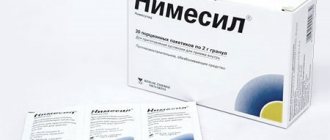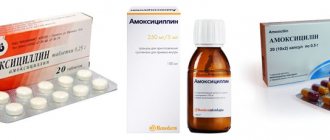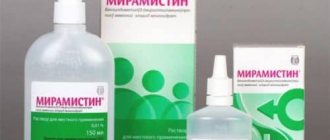Compound similarities
These drugs have the same release form - water-soluble powder. Their therapeutic effects are similar. Both drugs effectively reduce temperature and eliminate pain.
Nemulex contains the active substance – nimesulide.
Additional components:
- macrogol;
- sucrose;
- flavoring agents;
- citric acid;
- silicon.
The medicine has analgesic, anti-inflammatory, antipyretic, and antiaggregation properties. The product has good digestibility. The medicine remains at its highest concentration in the blood for 2.5 hours.
The drug quickly enters the lesion and is excreted by the liver and kidneys. Nemulex suppresses prostaglandins in the inflammatory focus. The medicine is used to treat negative symptoms. The medication eliminates pain and prevents the development of inflammation.
Indications for use:
- arthritis;
- muscle pain;
- joint pain;
- bursitis;
- tenosynovitis;
- pain during menstruation;
- headache;
- toothache;
- pain syndrome during the development of intervertebral hernia;
- pain after injuries and operations.
The product does not have a therapeutic effect, but eliminates pain and inflammation of an episodic nature.
Indications for use of Nemulex: arthritis, muscle pain, joint pain.
Nimesil is produced in the form of granules for oral administration and suspension. The active substance is the same - nimesulide.
Additional components:
- macrogol;
- maltodextrin;
- lemon acid;
- sucrose;
- flavorings.
The medicine is a non-hormonal anti-inflammatory drug. It has anti-inflammatory, antipyretic and analgesic properties.
The drug reduces the synthesis of prostaglandins by inhibiting cyclooxygenase. After oral administration, the drug is well absorbed, reaching its highest concentration in the blood after 2-3 hours. The drug is metabolized in the liver.
Indications for use:
- elimination of pain syndrome;
- relief from primary dysmenorrhea.
Comparison of safety of Nimesil and Nemulex
The safety of a drug includes many factors.
At the same time, with Nimesil it is quite similar to Nemulex. It is important where the drug is metabolized: drugs are excreted from the body either unchanged or in the form of products of their biochemical transformations. Metabolism occurs spontaneously, but most often involves major organs such as the liver, kidneys, lungs, skin, brain and others. When assessing the metabolism of Nimesil, as well as Nemulex, we look at which organ is the metabolizing organ and how critical the effect on it is.
The risk-benefit ratio is when the prescription of a drug is undesirable, but justified under certain conditions and circumstances, with the obligatory observance of caution in use. At the same time, Nimesil does not have any risks when used, just like Nemulex.
Also, when calculating safety, it is taken into account whether only allergic reactions occur or possible dysfunction of the main organs. In other matters, as well as the reversibility of the consequences of using Nimesil and Nemulex.
Differences between Nimesil and Nemulex
Despite the fact that these drugs are analogues, they also have differences.
Main differences:
- the price of Nemulex is less than Nimesil;
- they are made by various manufacturers;
- the taste and smell of the powder differs;
- Nemulex granules are larger than Nimesil;
- Nemulex in powder form often takes longer to dissolve in water.
But these differences are not significant; they do not affect the effectiveness of the drugs. Thus, apart from the price and slight differences in the composition of the components, these drugs do not differ in anything else. Both medications effectively eliminate pain and alleviate the patient's condition.
These medications should not be taken together, because they both contain the active ingredient nimesulide, and if taken at the same time, there may be an overdose that will cause side effects.
Both drugs have the same indications for use:
- osteoarthritis;
- arthritis;
- myalgia;
- arthralgia;
- headache and toothache.
Comparison of the effectiveness of Nimesil and Nemulex
The effectiveness of Nimesil is quite similar to Nemulex - this means that the ability of the drug substance to provide the maximum possible effect is similar.
For example, if the therapeutic effect of Nimesil is more pronounced, then using Nemulex even in large doses will not achieve this effect.
Also, the speed of therapy - an indicator of the speed of therapeutic action - is approximately the same for Nimesil and Nemulex. And bioavailability, that is, the amount of a drug reaching its site of action in the body, is similar. The higher the bioavailability, the less it will be lost during absorption and use by the body.
Contraindications
Nemulex and Nimesil have the following contraindications:
- intolerance to the components of the drug;
- bronchospasm;
- alcoholism;
- gastrointestinal bleeding;
- stomach and duodenal ulcers;
- cerebrovascular bleeding;
- increased bleeding;
- bleeding disorders;
- severe heart failure;
- liver and kidney dysfunction;
- flu;
- high body temperature;
- children under 12 years of age;
- pregnancy in the third trimester;
- lactation;
- hyperkalemia;
- if the patient has undergone coronary artery bypass surgery;
- diabetes.
Nimesil has the following contraindications: intolerance to the components of the drug, bronchospasm.
These drugs should not be used simultaneously with antiplatelet agents, glucocorticosteroids and anticoagulants.
NIMESIL
special instructions
Undesirable side effects can be minimized by using the drug in the minimum effective dose with the minimum duration of use necessary to relieve pain.
There is evidence of very rare cases of serious reactions from the liver, including cases of death, associated with the use of nimesulide-containing drugs. If symptoms similar to signs of liver damage appear (anorexia, itching, yellowing of the skin, nausea, vomiting, abdominal pain, dark urine, increased activity of liver transaminases), you should immediately stop using the drug Nimesil® and consult a doctor. Repeated use of Nimesil® in such patients is contraindicated.
Liver reactions, which are in most cases reversible, have been reported with short-term use of the drug.
While using the drug Nimesil®, the patient should refrain from taking other analgesics, including NSAIDs (including selective COX-2 inhibitors).
The drug Nimesil® should be used with caution in patients with a history of gastrointestinal diseases (ulcerative colitis, Crohn's disease), since exacerbation of these diseases is possible.
The risk of gastrointestinal bleeding, peptic ulcer/perforation of the stomach or duodenum increases in patients with a history of gastrointestinal ulceration (ulcerative colitis, Crohn's disease), as well as in elderly patients, with an increase in the dose of NSAIDs, so treatment should begin with the lowest possible dose. In such patients, as well as in patients who require the simultaneous use of low doses of acetylsalicylic acid or other drugs that increase the risk of complications from the gastrointestinal tract, it is recommended to additionally prescribe gastroprotectors (misoprostol or proton pump blockers). Patients with a history of gastrointestinal disease, especially older patients, should report new gastrointestinal symptoms (especially symptoms that may indicate possible gastrointestinal bleeding) to their physician.
Nimesil should be administered with caution to patients taking drugs that increase the risk of ulceration or bleeding (oral corticosteroids, anticoagulants such as warfarin, selective serotonin reuptake inhibitors or antiplatelet agents such as acetylsalicylic acid).
If gastrointestinal bleeding or gastrointestinal ulceration occurs in patients taking Nimesil®, treatment with the drug must be stopped immediately.
Given reports of visual impairment in patients taking other NSAIDs, if any visual impairment occurs, the use of Nimesil should be immediately discontinued and an ophthalmological examination performed.
The drug may cause fluid retention, therefore, in patients with arterial hypertension, renal and/or heart failure, Nimesil® should be used with extreme caution. If the condition worsens, treatment with Nimesil® should be discontinued.
Clinical studies and epidemiological data suggest that NSAIDs, especially at high doses and with long-term use, may lead to a small risk of myocardial infarction or stroke. There is insufficient data to exclude the risk of such events when using nimesulide.
Patients with arterial hypertension, renal and/or heart failure, coronary heart disease, peripheral arterial disease and/or cerebrovascular diseases, with risk factors for the development of cardiovascular diseases (for example: hyperlipidemia, diabetes mellitus, smokers) should take Nimesil® use with extreme caution. If the condition worsens, treatment with Nimesil® should be discontinued.
The drug contains sucrose, this should be taken into account by patients suffering from diabetes mellitus (0.15-0.18 XE per 100 mg of the drug) and those on a low-calorie diet. The drug Nimesil® is not recommended for use in patients with fructose intolerance, sucrose-isomaltose deficiency or glucose-galactose malabsorption syndrome.
If signs of a “cold” or acute respiratory viral infection occur while using the drug Nimesil®, the drug should be discontinued. Nimesulide can change the properties of platelets, so caution must be exercised when using the drug in people with hemorrhagic diathesis, however, the drug does not replace the preventive effect of acetylsalicylic acid in cardiovascular diseases.
Elderly patients are especially susceptible to adverse reactions to NSAIDs, including the risk of life-threatening gastrointestinal bleeding and perforation, and decreased renal, liver, and cardiac function. When taking Nimesil® for this category of patients, proper clinical monitoring is necessary.
There is evidence of rare cases of skin reactions (such as exfoliative dermatitis, Stevens-Johnson syndrome, toxic epidermal necrolysis) when taking NSAIDs, including nimesulide. At the first manifestations of a skin rash, damage to the mucous membranes or other signs of an allergic reaction, taking Nimesil® should be stopped immediately.
How to take Nimesil and Nemulex
Nemulex is taken as follows. It is necessary to dissolve the contents of the package in 0.5 cups of boiled water. For adult patients and children over 14 years of age, take 100 mg 2 times a day. The medicine is taken after meals. The course of treatment should last no more than two weeks.
Nimesil is taken in a short course. The product is drunk after meals. The course of treatment should not last more than 14 days. For adults, 100 ml of the active substance (1 sachet of powder) is prescribed 2 times a day. Children and the elderly are prescribed the same dosages. Before taking the medicine, you need to pour the contents of the sachet into a glass of water, dissolve and drink the product.
Comparison of side effects of Nimesil and Nemulex
Side effects or adverse events are any adverse medical event that occurs in a subject after administration of a drug.
Nimesil has more side effects than Nemulex. This implies that the frequency of their occurrence is low in Nimesil and low in Nemulex. Frequency of manifestation is an indicator of how many cases of an undesirable effect from treatment are possible and registered. The undesirable effect on the body, the strength of influence and the toxic effect of drugs are different: how quickly the body recovers after taking it and whether it recovers at all. When using Nimesil, the body's ability to recover faster is higher than that of Nemulex.
Side effects of drugs Nimesil and Nemulex
Side effects of Nemulex are:
- nausea;
- vomit;
- sleep disorders;
- increased blood pressure;
- dyspnea;
- stomach bleeding;
- depression.
Side effects of Nimesil:
- nausea;
- vomit;
- pain in the epigastrium;
- sleep disorders;
- gastrointestinal bleeding;
- arterial hypertension;
- acute renal failure;
- breathing problems;
- anaphylaxis.
Which painkiller is best?
Patients often ask me the question: “Which pain reliever is better?” This refers, first of all, to all kinds of drugs from the group of non-steroidal anti-inflammatory drugs. And many colleagues - doctors of other specialties - ask what is best to prescribe to patients. The answer to this question is not as simple as it seems, and should reveal, first of all, two criteria: effectiveness and safety.
What is more important to you? The achieved effect or the existing safety of the drug? What is preferable to get rid of pain in one or two days or ten days, or even a month? And if we add the criterion that in the first case there is a risk of gastrointestinal bleeding or heart complications? To begin with, in this article I want to address the issue of efficiency. Because it is with this criterion that everything is simple and clear.
All NSAIDs in recommended therapeutic dosages according to recommended treatment regimens are virtually equally effective. Hundreds of studies conducted, controlled by groups of patients receiving a placebo, a dummy, tens of millions of dollars and the work of thousands of doctors have shown that there is no significant difference between all existing painkillers from the NSAID group. And, as they say, if there is no difference, why pay more?
And the point lies in safety. I will not talk about the quality advantages and advantages of original drugs; this is discussed in detail here. A quality drug will always be safer.
Separately, the safety of painkillers in relation to the gastrointestinal tract, cardiovascular system and other organs should be considered.
It has been scientifically proven that selective COX-2 inhibitors are the safest for the gastrointestinal tract. However, not all of them are heart safe. On the other hand, naproxen was determined to be the safest drug for the cardiovascular system, which is not so safe for the gastrointestinal tract. Diclofenac more often than others causes an increase in liver enzymes, albeit reversibly, and nimesulide sometimes leads to acute toxic damage to the liver, even if this happens in one case out of many hundreds, but still several times more often than when taking other NSAIDs.
It is also always worth remembering about intolerance, the possibility of dependence of bronchial obstruction on taking NSAIDs, the presence of liver or kidney failure, a history of hemorrhagic episodes, etc.
It should also be noted that some drugs (Naizilat, Airtal) were released not so long ago and are still undergoing large-scale studies.
But you also need to take into account various risk factors, financial aspects and many other parameters. This is why one cannot call any painkiller the best. Each case is individual. And if you can, of course, take a pill for a single dose, then a course of treatment, for example, vertebrogenic pain syndrome, should be taken more seriously and consult a doctor. In any case, the competence of most doctors will be greater, while self-medication sometimes leads to dire consequences.
PS I honestly admit that, in most cases, I myself try to do without prescribing painkillers for a long course. Of all the drugs, we often have to limit ourselves to the drugs available in the clinic. At the outpatient clinic, I usually use aceclofenac, meloxicam, celecoxib (Celebrex), diclofenac and ketoprofen. At the same time, I always try to assess all risk factors, as well as the patient’s financial capabilities.
Reviews from doctors
Svetlana Anatolyevna, therapist
These drugs are prescribed when the patient urgently needs relief from pain. Medicines effectively eliminate headaches, toothaches, and pain during menstruation. Patients tolerate these medications well, but they cannot be taken for a long time. The course of treatment should not last more than two weeks.
Arkady Mikhailovich, rheumatologist
In patients with rheumatoid arthritis, when the disease worsens, joint pain intensifies and the inflammatory process worsens, these drugs are prescribed. They effectively cope with pain and inflammation.
Comparison of addiction between Nimesil and Nemulex
Like safety, addiction also involves many factors that must be considered when evaluating a drug.
So, the totality of the values of such parameters as “o syndrome” in Nimesil is quite similar to the similar values in Nemulex. Withdrawal syndrome is a pathological condition that occurs after the cessation of intake of addictive or dependent substances into the body. And resistance is understood as initial immunity to a drug; in this it differs from addiction, when immunity to a drug develops over a certain period of time. The presence of resistance can only be stated if an attempt has been made to increase the dose of the drug to the maximum possible. At the same time, Nimesil has a fairly low “syndrome” value, just like Nemulex.
Patient reviews
Alla, 35 years old
If pulpitis occurs, the doctor recommended taking Nimesil. He quickly eliminated severe toothache. The next day, when the severe pain had already disappeared, I went to see a dentist to treat a bad tooth.
Sergey Ivanovich, 60 years old
I have been suffering from osteoarthritis of the knee joints for several years. When the disease worsens, severe pain occurs and it becomes impossible to walk. In this case, the doctor advised taking Nemulex. I take the drug according to the instructions prescribed by the doctor. After a few days, the pain subsides.
Comparison of ease of use of Nimesil and Nemulex
This includes dose selection taking into account various conditions and frequency of doses. At the same time, it is important not to forget about the release form of the drug; it is also important to take it into account when making an assessment.
The ease of use of Nimesil is approximately the same as Nemulex. However, they are not convenient enough to use.
The drug ratings were compiled by experienced pharmacists who studied international research. The report is generated automatically.
Last update date: 2020-12-13 10:32:08










